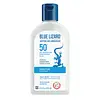What's inside
What's inside
 Key Ingredients
Key Ingredients

 Benefits
Benefits

 Concerns
Concerns

 Ingredients Side-by-side
Ingredients Side-by-side

Water
Skin ConditioningZinc Oxide 20%
Cosmetic ColorantCoco-Caprylate
EmollientDicaprylyl Carbonate
EmollientGlycerin
HumectantMicrocrystalline Cellulose
AbsorbentLauryl Glucoside
CleansingPropanediol
SolventCetyl Alcohol
EmollientPolyglyceryl-2 Dipolyhydroxystearate
Skin ConditioningEthyl Macadamiate
Skin ConditioningPolyhydroxystearic Acid
EmulsifyingSaccharide Isomerate
HumectantCoffea Arabica Husk Extract
AntioxidantHamamelis Virginiana Extract
AntiseborrhoeicXanthan Gum
EmulsifyingCellulose Gum
Emulsion StabilisingTasmannia Lanceolata Fruit/Leaf Extract
AntioxidantPolyglyceryl-4 Laurate
EmulsifyingPolyglyceryl-6 Caprylate
EmulsifyingUndaria Pinnatifida Extract
Skin ConditioningPhytic Acid
Helianthus Annuus Seed Oil
EmollientRosmarinus Officinalis Leaf Extract
AntimicrobialTriethoxycaprylylsilane
Caprylyl Glyceryl Ether
CleansingCaprylhydroxamic Acid
Water, Zinc Oxide 20%, Coco-Caprylate, Dicaprylyl Carbonate, Glycerin, Microcrystalline Cellulose, Lauryl Glucoside, Propanediol, Cetyl Alcohol, Polyglyceryl-2 Dipolyhydroxystearate, Ethyl Macadamiate, Polyhydroxystearic Acid, Saccharide Isomerate, Coffea Arabica Husk Extract, Hamamelis Virginiana Extract, Xanthan Gum, Cellulose Gum, Tasmannia Lanceolata Fruit/Leaf Extract, Polyglyceryl-4 Laurate, Polyglyceryl-6 Caprylate, Undaria Pinnatifida Extract, Phytic Acid, Helianthus Annuus Seed Oil, Rosmarinus Officinalis Leaf Extract, Triethoxycaprylylsilane, Caprylyl Glyceryl Ether, Caprylhydroxamic Acid
Titanium Dioxide 8%
Cosmetic ColorantZinc Oxide 10%
Cosmetic ColorantAlumina
AbrasiveAluminum Stearate
Cosmetic ColorantBeeswax
Emulsion StabilisingC12-15 Alkyl Benzoate
AntimicrobialCaprylyl Glycol
EmollientCetyl Dimethicone
EmollientCetyl PEG/PPG-10/1 Dimethicone
EmulsifyingChlorphenesin
AntimicrobialDimethicone
EmollientDisodium EDTA
Ethylhexyl Palmitate
EmollientEthylhexyl Stearate
EmollientHexyl Laurate
EmollientHydrogenated Castor Oil
EmollientMethyl Glucose Dioleate
EmollientOctyldodecyl Neopentanoate
EmollientPEG-7 Hydrogenated Castor Oil
EmulsifyingPhenoxyethanol
PreservativePolyglyceryl-4 Isostearate
EmulsifyingPolyhydroxystearic Acid
EmulsifyingPropanediol
SolventWater
Skin ConditioningSorbitan Oleate
EmulsifyingStearic Acid
CleansingTocopheryl Acetate
AntioxidantTriethoxycaprylylsilane
Trimethylsiloxysilicate
EmollientVp/Hexadecene Copolymer
Titanium Dioxide 8%, Zinc Oxide 10%, Alumina, Aluminum Stearate, Beeswax, C12-15 Alkyl Benzoate, Caprylyl Glycol, Cetyl Dimethicone, Cetyl PEG/PPG-10/1 Dimethicone, Chlorphenesin, Dimethicone, Disodium EDTA, Ethylhexyl Palmitate, Ethylhexyl Stearate, Hexyl Laurate, Hydrogenated Castor Oil, Methyl Glucose Dioleate, Octyldodecyl Neopentanoate, PEG-7 Hydrogenated Castor Oil, Phenoxyethanol, Polyglyceryl-4 Isostearate, Polyhydroxystearic Acid, Propanediol, Water, Sorbitan Oleate, Stearic Acid, Tocopheryl Acetate, Triethoxycaprylylsilane, Trimethylsiloxysilicate, Vp/Hexadecene Copolymer
 Reviews
Reviews

Ingredients Explained
These ingredients are found in both products.
Ingredients higher up in an ingredient list are typically present in a larger amount.
Polyhydroxystearic Acid is a soft wax made from castor oil.
It is is a texture thickener, emulsifier, and film-former. Emulsifiers prevent ingredients from separating, such as oils and waters.
Polyhydroxystearic Acid may not be fungal acne safe.
Learn more about Polyhydroxystearic AcidPropanediol is an all-star ingredient. It softens, hydrates, and smooths the skin.
It’s often used to:
Propanediol is not likely to cause sensitivity and considered safe to use. It is derived from corn or petroleum with a clear color and no scent.
Learn more about PropanediolTriethoxycaprylylsilane is a silicone used to bind and stabilize ingredients.
As an emulsifier, it helps prevent ingredients from separating. This can help elongate the shelf life of products.
Triethoxycaprylylsilane is often used to coat mineral sunscreens ingredients to help give a better feel. It also helps reduce oxidative stress in sunscreens.
Learn more about TriethoxycaprylylsilaneWater. It's the most common cosmetic ingredient of all. You'll usually see it at the top of ingredient lists, meaning that it makes up the largest part of the product.
So why is it so popular? Water most often acts as a solvent - this means that it helps dissolve other ingredients into the formulation.
You'll also recognize water as that liquid we all need to stay alive. If you see this, drink a glass of water. Stay hydrated!
Learn more about WaterZinc Oxide is a mineral broad-spectrum UV filter; it is the broadest UVA and UVB reflector approved by the FDA. It also has skin protectant and skin soothing properties.
Zinc oxide is one of the most effective broad-spectrum UV filters. It protects against UVB, UVAII, and UVAI. In comparison to its counterpart titanium dioxide, zinc oxide provides uniform and extended UVA protection.
Another great benefit? This ingredient is highly photostable so it won't degrade easily under sunlight.
A common myth is that mineral UV filters are widely believed to primarily reflect UV light.
However, modern research shows titanium dioxide absorbs UV radiation like chemical filters (~95% absorption & 5% reflection).
Zinc oxide has great skin soothing properties so you'll likely find this in sunscreens formulated for sensitive skin or babies/children. It is unlikely to cause "eye sting" like other sunscreen ingredients.
Regulatory agencies consider zinc oxide to be non-toxic and safe. It has also been shown to not penetrate the skin.
Unfortunately, this ingredient does leave a visible white cast. This is why mineral sunscreens are often less cosmetically elegant than chemical or hybrid ones.
In cosmetics, zinc oxide can be found in both non-nano and nano-sized forms. The nano version is used to reduce white cast and improve the texture of sunscreen formulas.
There are ongoing concerns surrounding nano-zinc oxide's impact on marine ecosystems and whether it can be absorbed into skin.
Regarding marine ecosystems and coral reefs, there is no conclusive evidence that any form of zinc oxide (or any other sunscreen ingredients) will cause harm. The science is still developing but many consumers are keeping a close eye on this issue.
Please note, many destinations have reef-safety sunscreen rules. For instance, the U.S. Virgin Islands advises all visitors to use non-nano mineral sunscreens.
There has also been some stir about whether micronized or nano zinc oxide has potential photoxicity and absorption through the skin/lungs.
An in-vitro (done in a test tube or petri dish) study demonstrated micronized zinc oxide to have potential phototoxicity. There's no need to fret; the EU Commission's Scientific Committee on Consumer Safety has stated, "The relevance of these findings needs to be clarified by appropriate investigations in vivo." Or in other words, further studies done on living organisms are needed to prove this.
Current research shows zinc oxide nanoparticles do not penetrate intact or sunburned skin. They either remain on the surface or in the outermost layer of dead skin (stratum corneum).
Zinc oxide is one of only two classified mineral UV filters with titanium dioxide being the other one.
Fun fact: Zinc has been used throughout history as an ingredient in paint and medicine. An Indian text from 500BC is believed to list zinc oxide as a salve for open wound. The Ancient Greek physician Dioscorides has also mentioned the use of zinc as an ointment in 1AD.
Learn more about Zinc Oxide